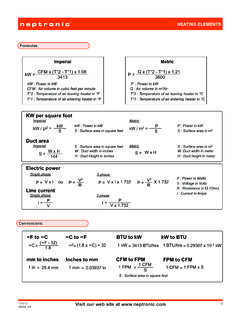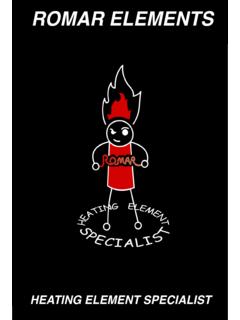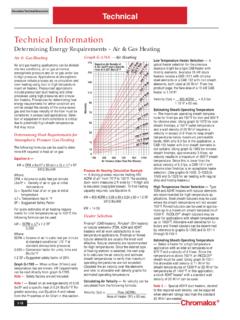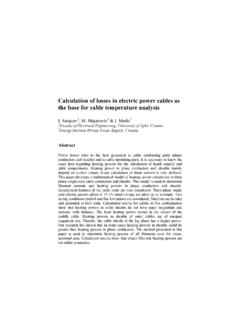Transcription of Buyer's Guide Natural Gas Heating System
1 Buyer's GuideNatural Gas Heating SystemBuyer's GuideNatural Gas Heating SystemIn most parts of the country, a home's Heating and cooling System is its largest energ yu s e r, so it's important to have an efficient, economical and reliable System . That's whym o re Americans use Natural gas Heating systems than any other kind. Natural gas can heat your home by creating warm air, hot water or steam. The most common type of System in the United States is a "forced-air" central Heating System thatuses a Natural gas burner to heat air. The air is then circulated through duct work in thehome by a blower or fan. H y d ronic or hot water systems have a gas boiler that creates steam or hot water, which is then circulated through the home through pipes or tubes.
2 These systems can use b a s e b o a rd components, radiators or pipes built into the floor. The energy efficiency of any Heating System is measured in its "Annual Fuel UtilizationE fficiency" (AFUE). This is the ratio between the amount of energy that goes into the System and the amount of energy that comes out as usable heat. It takes into considerationheat loses during start-up and cool-down, as well as the unit s efficiency while it s ru n n i n g .Most older Natural gas furnaces or boilers have efficiencies lower than 65 percent, buttoday's Natural gas systems have AFUE ratings that range from 78 to 97 percent. Natural gas Heating systems come in many diff e rent sizes, types, configurations and e fficiency ratings.
3 This Guide will help you choose the right Heating System for your home and family. - 1 -xTable Of ContentsSelecting a New Natural Gas Heating SystemTypes of Gas Heating SystemsCentral HeatingForced Air SystemsHydronic or Water-Based SystemsCombination Water Heating /Space Heating SystemsRoom or Supplemental Space HeatersZoned Heating SystemsSizing Energy Efficiency Ratings (AFUE)Cost ComparisonsMaking Your SelectionHow To Select a Qualified Heating ContractorUse and MaintenanceGlossarySelecting A Natural Gas Heating SystemB e f o re you start shopping, it s helpful to understand some basics: warm air is lighter than cold air, so it riseswhile cold air falls.
4 In large areas, such as a home, the air is constantly moving. The bigger the diff e re n c ebetween cold and warm, the faster the air moves. This can create drafts, so maintaining a relatively even tem-p e r a t u re in your home will make you more comfort a b l e . Heating can take place in three diff e rent ways: convection, conduction or radiant Heating . Convection takesadvantage of warm air s tendency to rise -- the warm air warms surfaces as it moves. Radiant Heating doesn tw a rm air. Like the sun s rays, it warms objects in its direct path. The heated objects -- like people or walls --can also give off radiant heat to cooler materials.
5 Conventional fireplaces, for example, give off radiant heat,while warm air Heating systems use convection Heating . Conduction carries heat through a material, like ad o o r, rather than through air. The heat could come from warm air or from radiant heat. The more dense thematerial, the more easily it conducts heat. Less dense materials, like insulation batting, slow down the heatgoing through a home s walls and ro o f .When you re ready to shop, here s how to get start e d : Decide which type of Natural gas Heating System is best for your home, with guidance from thedescriptions below. With help from a professional, determine the size unit you need.
6 D e t e rmine what your venting options are, especially if you are converting from another energy tonatural gas or are relocating the Heating System within the house. C o m p a re purchase prices and operating costs of diff e rent systems. (A higher efficiency System maycost a little more initially, but may pay for itself in operating costs savings in a short time.) Obtain bids from two or more contractors on the unit you choose. Some contractors may have verysimilar equipment, but from diff e rent manufacturers. Compare warranties on both the equipment and the installation. Be sure the models you are considering are design-certified by a nationally recognized laboratorythat tests to national standard s.
7 Follow the manufacture r s recommendations for use and maintenance, including an annual inspec-tion of the Heating and venting Of Natural Gas Heating SystemsNatural gas Heating options range from large central Heating units to small wall units or gas fireplaces. If youa re replacing an existing forced-air or boiler central Heating System , it probably will be more economical toinstall the same type of System . Some steam systems, however, can be converted to hot water heat. If you are adding on a room, a space heater or fireplace-style Heating unit may be the better choice. This isespecially true if your current furnace is sized properly for the existing house and might be too small to heatany additional space.
8 - 1 -If you are building a new home, you might consider radiant floor Heating , which uses hot water circ u l a t e dt h rough piping built into the floor, or a combination space Heating and water Heating System , which uses onegas burner to do two jobs. Read the descriptions below to determine what type would be best for you, andconsult a qualified contractor to help you. Central HeatingB a s i c a l l y, central home- Heating equipment consists of three separate systems: a unit where heat is created, adistribution System for the heat produced, and a control System that regulates when the Heating and distribu-tion systems are turned on and off. The Heating unit is composed of a cabinet containing a Natural gas burner and a heat exchanger that transfersheat from the gas burner to either an air, steam or water delivery System .
9 The burner is turned on by either astanding pilot light or an electronic or spark ignition. The heated air, steam or water is then moved to the loca-tion where it is needed by a device like a blower fan or water pump. The burner and delivery System are con-t rolled by a thermostat, which turns the Heating System on and off to maintain a comfortable temperature inthe home. Other controls, such as dampers and vents, can also be used to control delivery. Some Natural gas heatingsystems offer zoned heat -- diff e rent temperatures for diff e rent parts of the home, or a modulating System thatraises and lowers the burner and/or the fan or pump to maintain a perfect comfort Natural gas combustion produces some byproducts, all Natural gas central Heating systems haveventing that exhausts these byproducts to the outdoors.
10 The specifics for each type of System are discussedb e l o o rced Air SystemsThe most common type of Natural gas central- Heating System is forced air, which uses a Natural gas burner toc reate warm air. These units have AFUEs ranging from 78 percent, which is the minimum efficiency nowallowed under federal regulation for these systems, up to 97 perc e n t .In forced-air systems, the furnace draws in cool air and moves it into a heat exchanger, a metal box, where it sw a rmed by the gas burn e r. An electric fan or blower then pushes the warmed air through a filter and intoducts or registers throughout the home. (In very old "gravity" systems, the warm air rises naturally withoutany mechanical assistance.)




![t } } o h o u Z ] o o ^ } o µ } v ^ ] u µ o v } µ , v P v ...](/cache/preview/d/5/8/c/b/5/3/4/thumb-d58cb53409acc8a3dc323250eb01b665.jpg)

